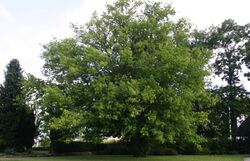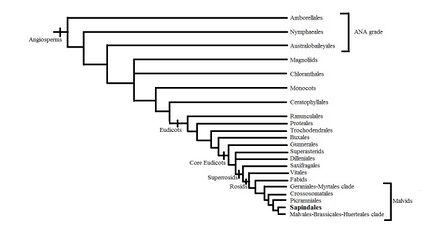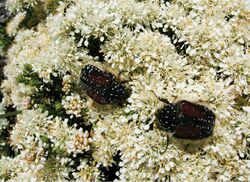Biology:Sapindales
| Sapindales | |
|---|---|

| |
| Manitoba Maple (Acer negundo) | |
| Scientific classification | |
| Kingdom: | Plantae |
| Clade: | Tracheophytes |
| Clade: | Angiosperms |
| Clade: | Eudicots |
| Clade: | Rosids |
| Clade: | Malvids |
| Order: | Sapindales Dumortier |
| Families | |
|
See text | |
Sapindales /sæpɪnˈdeɪliːz/ is an order of flowering plants. Well-known members of Sapindales include citrus; maples, horse-chestnuts, lychees and rambutans; mangos and cashews; frankincense and myrrh; mahogany and neem.

The APG III system of 2009 includes it in the clade malvids (in rosids, in eudicots) with the following nine families:[2][3][4]

thumb|190px|Chloroxylon swietenia'' from Rutaceae
- Anacardiaceae
- Biebersteiniaceae
- Burseraceae
- Kirkiaceae
- Meliaceae
- Nitrariaceae (including Peganaceae and Tetradiclidaceae)
- Rutaceae
- Sapindaceae
- Simaroubaceae
The APG II system of 2003 allowed the optional segregation of families now included in the Nitrariaceae.
In the classification system of Dahlgren the Rutaceae were placed in the order Rutales, in the superorder Rutiflorae (also called Rutanae). The Cronquist system of 1981 used a somewhat different circumscription, including the following families:
- Staphyleaceae
- Melianthaceae
- Bretschneideraceae
- Akaniaceae
- Sapindaceae
- Hippocastanaceae
- Aceraceae
- Burseraceae
- Anacardiaceae
- Julianiaceae
- Simaroubaceae
- Cneoraceae
- Meliaceae
- Rutaceae
- Zygophyllaceae
The difference from the APG III system is not as large as may appear, as the plants in the families Aceraceae and Hippocastanaceae stay in this order at APG III (both included in family Sapindaceae). The species now composing the family Nitrariaceae in APG III also belonged to this order in the Cronquist system as part of the family Zygophyllaceae, while those now in the family Kirkiaceae were present as part of the family Simaroubaceae.
References
- ↑ Byng et al. (2016). "An update of the Angiosperm Phylogeny Group classification for the orders and families of flowering plants: APG IV". Botanical Journal of the Linnean Society 181: 1–20. doi:10.1111/boj.12385.
- ↑ Angiosperm Phylogeny Group III (2009). "An update of the Angiosperm Phylogeny Group classification for the orders and families of flowering plants: APG III". Botanical Journal of the Linnean Society 161 (2): 105–121. doi:10.1111/j.1095-8339.2009.00996.x.
- ↑ Muellner, A. N.; D. D. Vassiliades; S. S. Renner (2007). "Placing Biebersteiniaceae, a herbaceous clade of Sapindales, in a temporal and geographic context". Plant Systematics and Evolution 266 (3–4): 233–252. doi:10.1007/s00606-007-0546-x. Bibcode: 2007PSyEv.266..233M. http://www.umsl.edu/~renners/Biebersteinia_PSE_2007.pdf.
- ↑ Stevens, P.F. (2001–2008). "Angiosperm Phylogeny Website. Version 9, June 2008 [and more or less continuously updated since."]. Missouri Botanical Garden. http://www.mobot.org/mobot/research/apweb/.
Bibliography
- Pell, Susan Katherine (May 2004) (PhD thesis). Molecular systematics of the cashew family (Anacardiaceae). Department of Biological Sciences, Louisiana State University. http://etd.lsu.edu/docs/available/etd-04152004-101232/unrestricted/Pell_dis.pdf.
Wikidata ☰ Q26316 entry
 |

